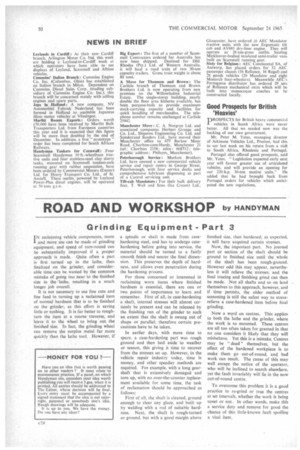ROAD AND WORKSHOP by HANDYMAN
Page 52

If you've noticed an error in this article please click here to report it so we can fix it.
Grinding Equipment Part 3
IN reclaiming vehicle components, more
and more use can be made of grinding equipment, and speed of turn-round can be substantially improved if a proper approach is made. Quite often a part is first turned up in the lathe, then finalized on the grinder, and considerable time can be wasted by the common mistake of going too near to the finished size in the 'lathe. resulting in a much longer job overall.
It is not necessary to use fine cuts and fine feed in turning up a reclaimed item of normal hardness that is to be finished on the grinder, as this effort is saving little or nothing. It is far better to roughturn the item at a coarse traverse, and leave it to the wheel to bring out the finished size. In fact, the grinding wheel can remove the surplus metal far more quickly than the lathe tool. However, if
a spindle or shaft is made from casehardening steel, and has to undergo casehardening before going into service, the material should be turned to a fairly smooth finish and nearer the final dimension. This preserves the depth of hardness, and allows even penetration during the hardening process.
For those concerned or interested in reclaiming worn items where finished hardness is essential, there are one or two points of importance to learn and remember. First of ail, in case-hardening a shaft, internal stresses will almost certainly be present and can be released by the finishing run of the grinder to such an extent that the shaft is swung out of shape or parallel; therefore certain precautions have to be taken.
In earlier days, with more time to spare, a case-hardening part was rough ground and then laid aside to weather or season, this giving it time to recover from the stresses set up. However, in the vehicle repair industry today, time is money. and other speedier methods are required. For example, with a long gearshaft that is extensively damaged and torn up, with no over-the-counter replacement available for some time, the task of reclamation should be approached as follows: First of all, the shaft is cleaned, ground enough to clear any glaze. and built up by welding with a rod of suitable hardness. Next, the shaft is rough-turned or ground. but with a good margin above
finished size, then hardened; as expected, it will have acquired certain stresses.
Now, the important part. No journal part or section of the shaft should be ground to finished size until the whole of the shaft has been rough-ground. However odd this may appear,.nevertheless it will relieve the stresses, and the final trueing and finishing grind can then be made. Not all shafts and so on lend themselves to this approach, however, and if time permits, the older method of seasoning is still the safest way to stressrelieve a case-hardened item before final grinding.
Now a word on centres. This applies to both the lathe and the grinder, where the work is so mounted. These centres are all too often taken for granted in that no one considers it likely that they will misbehave. 'Yet this is a mistake_ Centres may be " dead " themselves, but the effect of the hardened workpiece is to make them go out-of-round, and bad work can result. The cause of this may well escape the notice of the operator, who will be inclined to search elsewhere, yet the fault invariably will lie in the now out-of-round centre,
To overcome this problem it is a good practice to re-grind or true the centres at set intervals, whether the work is being upset or not. In other words, make this a service duty and remove for good the chance of this little-known fault spoiling a vital item.
























































































































